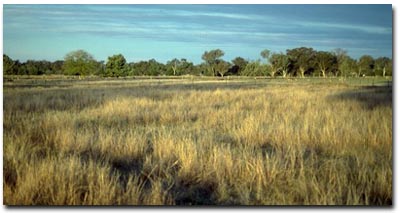Lilliput Loam
Lilliput Loam has a profile distinguished by an ashy grey strongly bleached subsurface (A2) horizon and grey intractable clay in the deep subsoil. The A2 horizon often has a distinct silty or floury consistence, and its transition to the B horizon is abrupt. The soil type is poorly drained both internally and externally.
Unit 2 is a gilgai complex containing four soil types. Lilliput Loam is the depression component of this complex.
Lilliput Loam also forms a complex with Black Dog Fine Sandy Loam on the southern part of the Station.
 Gilgai Country in Mapping Unit 2 |
Typical Profile
| Surface | ||
| A1 | 0-15 cm | (Dark) grey-brown (10YR5/3) to grey loam or fine sandy loam, with fine rusty root channel mottling; usually a trace of buckshot; friable when moist; 10 to 20 cm thick; separated by a clear boundary from: |
| A2 | 15-40 cm | Light grey or grey (10YR6/1 - 2.5YR7/2) strongly bleached (10YR7-8/1 dry) silty loam to fine sandy loam; sometimes increasing to clay-loam just above the B horizon; brittle when dry, usually weakly compacted and structureless; small vesicle irregularly present; light, often increasing to moderate buckshot; 7 to 30 cm thick; sharply separated from: |
| Subsoil | ||
| B21 | 40-67 cm | Grey to brownish grey (10YR5/1 - 6/3) or grey mottled clay; tough and intractable; moderate prismatic structure, with some bleached A2 material frequently present between the prisms; at depths varying from 60 to 90 cm grading into: |
| B22 | 67-120 cm | Diffusely or moderately mottled clay, with colours varying from brownish grey and olive to yellowish brown (2.5Y6/4); usually crumbly; calcium carbonate and scattered black inclusions irregularly present. |
Soil Site NE37a is an example of Lilliput Loam found in the depressions of gilgai microrelief within Unit 2.
Variations
The A horizon varies considerably in thickness and some profiles have a subsoil clay as shallow as 25 cm and as deep as 60 cm. Where the soil type occurs with Black Dog Fine Sandy Loam in the southern part of the Station, the A horizon is somewhat coarser than elsewhere on the plain.
The distinct layer (older land surface) which marks the deep subsoil of nearly all the other soil types has only occasionally been identified in Lilliput Loam.
Relationship to Other Soil Types
Lilliput Loam shares a strongly bleached A2 horizon with Black Dog Fine Sandy Loam. Where the two soil types occur together, it is distinguished from Black Dog Fine Sandy Loam by a:
- grey or grey mottle instead of a yellow mottled clay.
- tough and intractable (instead of a crumbly) deeper subsoil clay.
- generally more abrupt boundary between the A and B horizons.


